An Introduction to Black Widow Spiders
Check Your Firewood Before Bringing It Inside
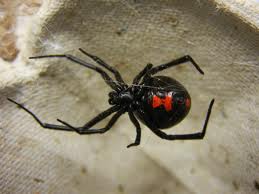
Every year around this time I'm reminded that it's important to check firewood carefully before it comes inside. We keep our wood under a tarp outside near the house. Many different invertebrates, and even salamanders and other reptiles, will overwinter in a wood pile. Be sure to shake off the wood you bring inside because the warm interior of your house is a perfect place to "wake-up" and start crawling around if you're an insect!
Black Widows are Common Residents of Wood Piles
Black widow spiders are a type of spider in the family Theridiidae. There are 32 species in their genus but the most common species found in Eastern North America is Latrodectus mactans (roughly translated to "murderous biting robber"). The name Latrodectus comes from the neurotoxin found in the spiders called latrotoxin. The condition caused by their bite is called latrodectism. Females are the only ones that bite and cause problems with their venom. The males have venom glands too, but the female's venom is about 3x stronger than the male's. The black widow's bite can be painful but rarely fatal.
Did You Know There are Four Black Widow Species Native to North America (and one introduced)?
The black widow that is most commonly known in the Eastern US is the Southern Black Widow. Latrodectus mactans. It is a part of the "Four sisters" of the black widow world of native North American black widows.
The Northern Sister (L. variolus) or Northern Black Widow: found on the East Coast from upper Fla. to Canada. [L. variolus has non-touching triangles that make up the hourglass on its belly]
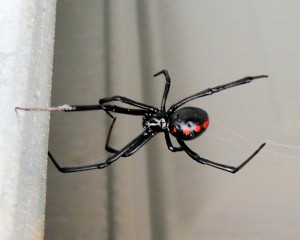
The Southern Sister (L. mactans) or Southern Black Widow (mentioned above): found in the South and North East US.
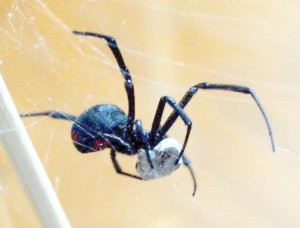
The Western Sister (L. hesperus) or the Western Black Widow: found in the mid-West and Western US.
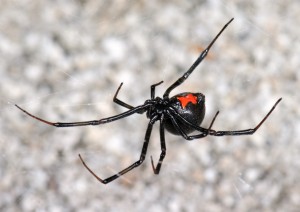
South Eastern Sister (L. Bishopi)or Red Widow; Found in central Florida.
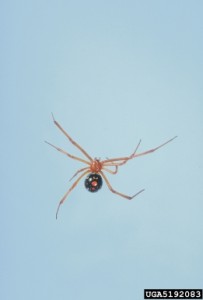
Introduced: The Brown Widow (L. geometricus)
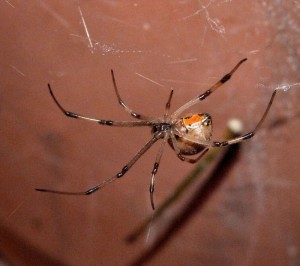
A great website where you can find out more about these different species is the BugGuide.net website.
How to Recognize a Black Widow (L. mactans)
Note: I'm using L. mactans because it's the most common black widow in my region, but also because it's the archetype of all black widows.
Females
- About 1/2" long
- Shiny black
- Swollen large black abdomen
- Under her abdomen you will see an hourglass shape that ranges in color from yellow-orange to red.
- A red spot just above and behind her spinnerets on the abdomen.
- Long skinny legs that appear almost hairless
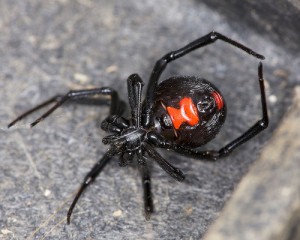
Males
- About 3/4" long
- Dull blackish grey to brownish
- Often has a tiny red spot on its abdomen
- Body is more elongate than the female's
- May have brownish stripes with a dot of yellow or red on the top of the abdomen
- Completely harmless
Webs of Black Widows
Black widow spiders are tangle web weavers. They don't make a particular pattern. The strands of their webs are clearly defined and don't resemble cob webs, even though the strands are cris-crossed in no discernible pattern.
How to Prevent Blak Widow Bites
To prevent black widow bites make sure that you keep dark and damp areas clean and clear of webs. Wear long-sleeved shirts when moving firewood, boxes, rocks, or in dusty undisturbed places in your house. Use insect repellents on your clothing and shoes or boots.
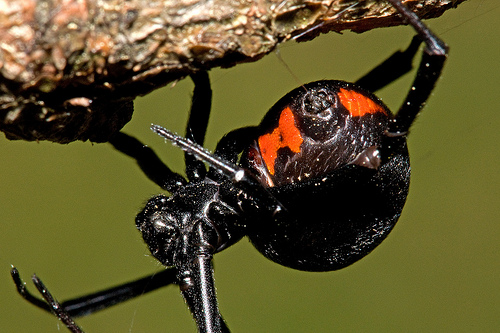
Black Widow Bites and Treatment
Many people don't even realize they've been bitten by a black widow spider because the bite area may be small or painless. However there are some general signs to look for:
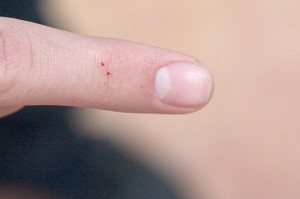
- One or two bite marks, small raised bumps on the skin that looks like a target.
- Swelling in the area of the bite, locally focused.
- Pain may progress from the site to your back or abdomen.
- You may also feel cramps in your abdominal muscles, or abdominal rigidity in your stomach muscles.
- Some may have nausea, labored breathing, raised blood pressure, and sweating.
- These symptoms may last for up to 12 hours, though the after effects may linger for a few days.
To treat a bite you should first clean it with an antibacterial soap and water, and then apply ice to slow the movement of the venom. If you can elevate the body part affected and immobilize it, don't move around a lot. You should also seek medical attention, especially those with heart conditions. In the field I always circle the bite with non-toxic marker so that I can watch for swelling or other symptoms. This can be useful for small bites and finding it later if swelling occurs.
Black widow venom is a neurotoxin and it works on the nerve ending receptors in the body of insects, crustaceans, and vertebrates. The latrotoxins cause the release of neurotranmistters from the nerves of the body, and they also bind to the receptors. This nerve firing is what causes the pain that those who are bitten feel.
Do Female Black Widows Really Eat the Males?
Yes, the females do really eat the males after mating. Why do they eat the males? There's speculation about the reason the female does this, most likely it's to ensure that the female has a good "food meal" ensuring that she has enough energy to lay eggs and survive.
Are Black Widows Good For Anything?
Black widows are spiders and like other spiders, and they prey on insects in and around our homes. They control pests and they are the apex predators of the insect world. If you can remove one to a remote location where it won't cause harm to humans do so CAREFULLY!

